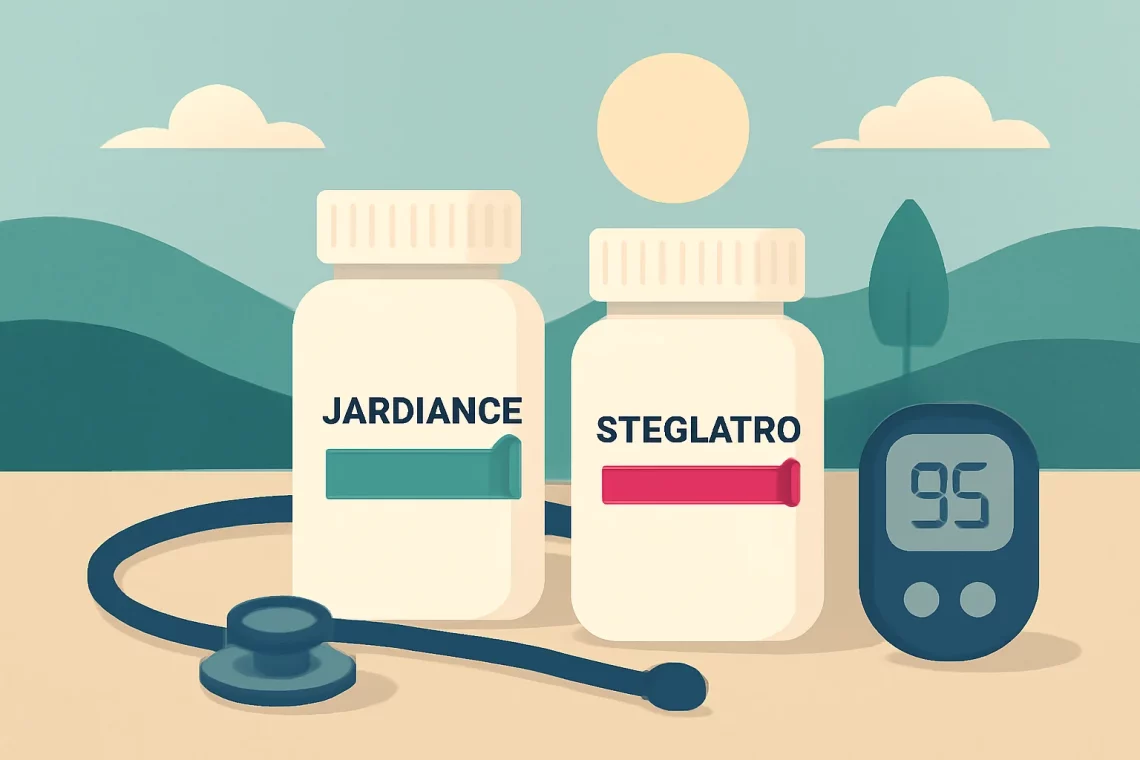
Jardiance vs Steglatro: Which Diabetes Medication is Right for You?
Jardiance and Steglatro are two medications that belong to the class of drugs known as SGLT2 inhibitors, which are primarily used to manage type 2 diabetes. As the prevalence of diabetes continues to rise globally, the importance of understanding various treatment options becomes increasingly significant. Both Jardiance (empagliflozin) and Steglatro (ertugliflozin) offer unique benefits and potential side effects that can influence a patient’s choice of treatment. The mechanism of action for these medications revolves around helping the kidneys eliminate excess glucose through urine, thus lowering blood sugar levels.
Patient experience, efficacy, and safety profiles are key considerations when evaluating these medications. With the growing emphasis on personalized medicine, understanding how these drugs interact with individual health conditions and lifestyles is crucial. Furthermore, the comparison between Jardiance and Steglatro extends beyond efficacy; it also includes aspects like dosage, potential side effects, and any additional health benefits they may provide. As patients and healthcare providers explore treatment options, a comprehensive understanding of Jardiance and Steglatro can facilitate informed decisions that align with individual health goals and preferences.
Understanding Jardiance: Mechanism and Benefits
Jardiance, or empagliflozin, is an SGLT2 inhibitor that works by preventing the reabsorption of glucose in the kidneys, thus promoting its excretion through urine. This mechanism not only helps lower blood sugar levels but also contributes to weight loss, which is often a significant concern for individuals managing type 2 diabetes. The drug is typically prescribed alongside a balanced diet and exercise regimen to enhance its effectiveness.
One of the standout benefits of Jardiance is its cardiovascular protective effects. Clinical studies have indicated that patients using Jardiance may have a lower risk of cardiovascular events, such as heart attack and stroke. This is particularly important for individuals with type 2 diabetes, who often face an increased risk of heart-related issues. Additionally, Jardiance has been associated with a reduction in hospitalization due to heart failure, highlighting its potential dual benefit in managing both blood sugar levels and heart health.
Patients taking Jardiance may also experience improvements in kidney function over time. This is crucial, as diabetes can lead to kidney damage, and protecting kidney health is essential for long-term well-being. The drug’s ability to enhance renal function can provide added reassurance for patients concerned about the complications associated with diabetes.
However, like any medication, Jardiance does come with potential side effects. Common adverse reactions include urinary tract infections, genital fungal infections, and dehydration, particularly in older adults. It is vital for patients to discuss these potential side effects with their healthcare provider to determine if Jardiance is the right fit for their treatment plan.
In summary, Jardiance offers multiple benefits beyond glucose management, including cardiovascular protection and kidney health support. The decision to use Jardiance should be based on a thorough discussion with a healthcare professional, considering the patient’s overall health, medical history, and treatment goals.
Exploring Steglatro: Features and Advantages
Steglatro, or ertugliflozin, is another SGLT2 inhibitor that provides a similar mechanism of action to Jardiance but with its own unique profile. As with other drugs in this class, Steglatro works by inhibiting the reabsorption of glucose in the kidneys, allowing for increased glucose excretion and improved blood sugar control. This makes it a suitable option for patients looking to manage their diabetes effectively.
One of the key advantages of Steglatro is its flexibility in combination therapy. It can be used in conjunction with other diabetes medications, such as metformin or insulin, to achieve better glycemic control. This adaptability makes Steglatro a valuable choice for patients who may require a multi-faceted approach to their diabetes management.
Steglatro has also demonstrated benefits in terms of weight management. Many patients experience weight loss while taking the medication, which can be advantageous given that obesity is a common issue among those with type 2 diabetes. Additionally, like Jardiance, Steglatro may provide cardiovascular benefits, as studies suggest it can lower the risk of heart-related complications.
However, patients should be aware of potential side effects, which can include urinary tract infections, dehydration, and potential kidney function concerns. As with any medication, it is essential for patients to have open discussions with their healthcare providers about any existing health conditions and how Steglatro may fit into their overall treatment plan.
In conclusion, Steglatro offers a robust option for managing type 2 diabetes, particularly for those looking for a combination therapy solution. Its effects on weight and cardiovascular health further enhance its appeal, making it a strong contender alongside other diabetes treatments. A careful assessment with a healthcare professional will help ensure that Steglatro is the right choice for individual patient needs.
Comparative Efficacy: Jardiance vs. Steglatro
When comparing Jardiance and Steglatro, it’s essential to evaluate their efficacy in controlling blood sugar levels and their overall impact on a patient’s health. Both medications have demonstrated effectiveness in clinical trials, but there may be subtle differences that could influence a patient’s choice.
Jardiance has been extensively studied and is well-established in the diabetes community, particularly for its cardiovascular benefits. Evidence suggests that it significantly reduces the risk of heart failure and related complications, making it a compelling option for patients with existing heart issues. On the other hand, while Steglatro also shows promise for cardiovascular health, its data may not be as robust as Jardiance’s in this specific area.
In terms of glycemic control, both medications effectively lower HbA1c levels, which is a critical measure of long-term blood sugar management. However, individual responses to these drugs can vary, with some patients finding one medication more effective than the other. It’s crucial for individuals to monitor their blood sugar levels closely when starting a new medication and to communicate with their healthcare provider about their experiences.
Furthermore, adherence to medication is a significant factor in diabetes management. Patients often prefer medications that are easy to incorporate into their daily routines. Both Jardiance and Steglatro are taken orally, typically once daily, which can enhance patient compliance. However, the choice between the two may ultimately depend on how a patient tolerates each medication and the specific side effects they experience.
In summary, while both Jardiance and Steglatro are effective options for managing type 2 diabetes, their comparative efficacy may vary based on individual patient factors. A thorough evaluation with a healthcare provider will help determine the most suitable option for each patient, considering their unique health profile and treatment goals.
Patient Experiences and Considerations
Patient experiences with Jardiance and Steglatro can greatly influence treatment decisions. Individual responses to medications can vary widely based on factors such as lifestyle, diet, and existing health conditions. Many patients report positive experiences with both medications, citing improved blood sugar control, weight loss, and enhanced energy levels.
However, it is essential to recognize that both medications can also cause side effects, which may impact a patient’s willingness to continue treatment. Common side effects such as urinary tract infections and dehydration can be concerning for some individuals. Patients should be proactive in discussing any adverse reactions they experience with their healthcare provider, as this can lead to adjustments in their treatment plan.
Another critical consideration is the cost and availability of these medications. Depending on insurance coverage and local pharmacy prices, the out-of-pocket expense for Jardiance and Steglatro can vary significantly. Patients should explore their options and discuss with their healthcare provider about potential assistance programs or alternatives if cost is a barrier to adherence.
Finally, patient education is paramount. Understanding how these medications work, their benefits, and potential risks can empower patients to make informed decisions about their diabetes management. Engaging in open dialogue with healthcare professionals can provide valuable insights and help tailor treatment plans to better suit individual needs.
In conclusion, patient experiences play a vital role in the effectiveness of Jardiance and Steglatro. By considering personal preferences, potential side effects, and cost factors, individuals can work collaboratively with their healthcare providers to find the most effective diabetes management strategy.
**Disclaimer:** This article is for informational purposes only and does not constitute medical advice. Always consult your healthcare provider for medical advice and treatment options tailored to your individual needs.




